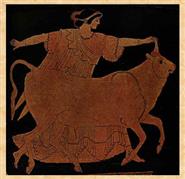Security and Durability
The ECB and the national central banks (NCBs) of the Eurosystem are responsible for the integrity of euro banknotes.
So they have developed a second series of euro banknotes with enhanced security features which will help to make the
banknotes even more secure and maintain public confidence in the currency. The new euro banknotes benefit from
advances in banknote technology. The Eurosystem's research and development strategy states that euro banknotes
need to be "self-defending", thereby making life difficult for counterfeiters. Credit institutions, professional
cash handlers and the public need to be able to recognise counterfeit banknotes and thus help to support the
Eurosystem's anti-counterfeiting strategy.
The most notable new security feature is a portrait of Europa (a figure from Greek mythology) in the watermark and
the hologram. This portrait was chosen because it has an obvious link to the continent of Europe and also adds a human
touch to the banknotes.
| Hologram | Watermark | Emerald number |
|---|

|

|

|
| When you TILT the banknote, the silvery stripe reveals a portrait of Europa, the same as
in the watermark. The stripe also shows a window and the value of the banknote |
When you LOOK at the banknote against the light, a faint image becomes visible
and shows a portrait of Europa, the value of the banknote and a window |
When you TILT the banknote, the shiny number displays an effect of the light that moves
up and down. The number also changes colour from emerald green to deep blue |
The new euro banknotes are also more durable than the first series. They will not need to be replaced as quickly.
That's important, especially for the €5 banknote, as it is subject to a lot of wear and tear. Its longer life
will also reduce the new banknote's environmental impact.
Redesigning banknotes

A portrait of Europa, a figure from Greek mythology, has been incorporated into some of the security features of
the new series of euro banknotes. This is why it is called the Europa series. In Greek mythology, Europa, the daughter
of a Phoenician king, was seduced by the god Zeus, in the shape of a bull, who carried her away to Crete. The story
inspired the ancient Greeks to use “Europe” as a geographical title.
Portraits have traditionally been used on banknotes all over the world. Research has shown that people tend to
recognise faces easily. The portrait of Europa was chosen to feature in the new euro banknotes because it has an
obvious link to the continent of Europe and also adds a human touch to the banknotes. This particular image was
taken from a vase in the Louvre in Paris. The vase dates back over 2,000 years and was found in southern Italy.
Gradual introduction
The introduction of the Europa series of banknotes will differ from the euro changeover in 2002 for several reasons.
The various denominations are being issued at different points in time, so the introduction of the whole series will
take several years, unlike the big-bang changeover which took place in 2002.
Given the gradual introduction of the new banknotes and the fact that each country has its own “cash cycle”, the
speed of change will vary across the euro area. The time it takes for the new banknotes to displace the older ones
will differ from one country to another. By autumn 2013 the new €5 banknotes are expected to outnumber those of the
first series at the euro area level.
In order to use up remaining stocks, in many euro area countries the €5 banknotes of the first series will be issued
for several months alongside the new €5 banknotes. The two series will circulate in parallel as legal tender. The date
when the first series ceases to be legal tender will be announced well in advance; however, the first series of
banknotes will be exchangeable for an indefinite period of time at the